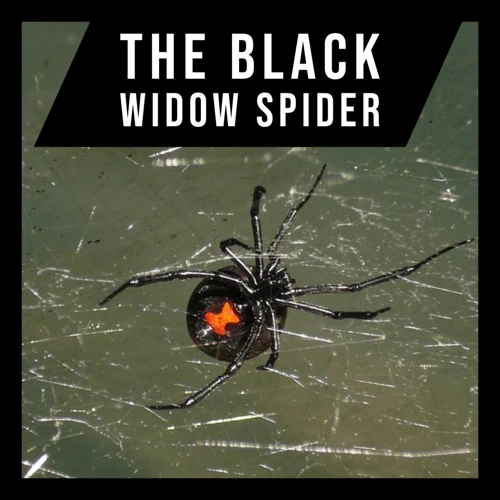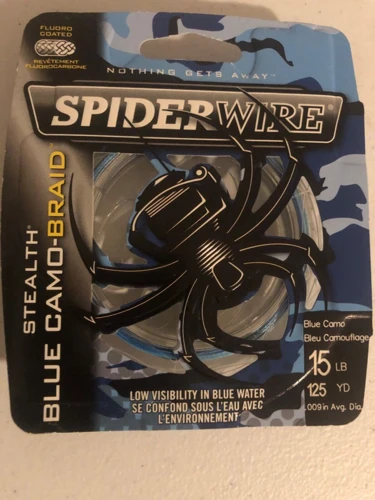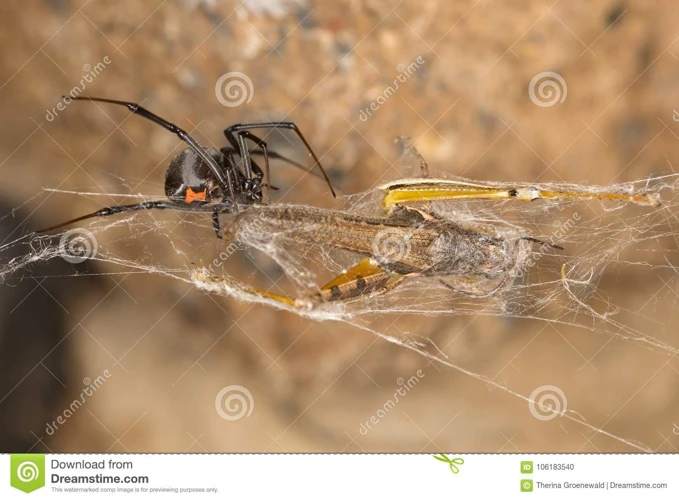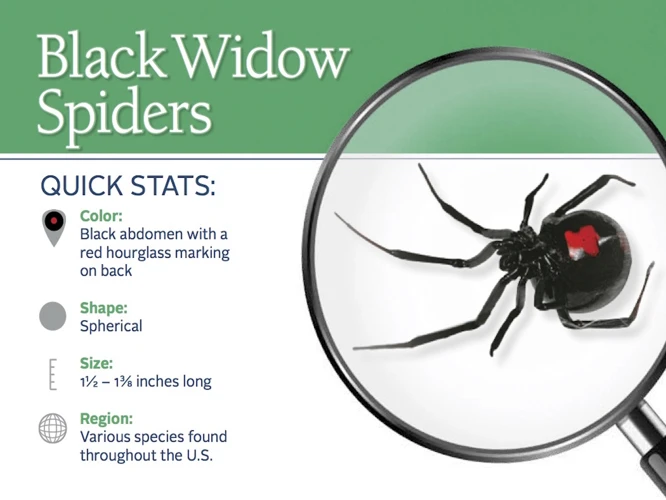As we admire the beauty of black widow spiders, we wonder: how do these delicate creatures survive in the wild? Particularly at night, when dangers lurk everywhere. In this article, we’ll explore the incredible ways in which black widow spiders avoid predators and continue to thrive, even in the darkest of nights. From their impressive camouflage and stealth tactics to their intricate web weaving techniques and sensory adaptations, these spiders have developed highly-effective strategies to evade danger and stay safe. Join us on this fascinating journey as we delve deeper into the world of these enigmatic creatures.
The Importance of Avoiding Predators

As one of the most venomous spiders on the planet, the black widow spider has a lot to worry about, and avoiding predators is a crucial survival tactic. Throughout their life cycle, these spiders are constantly threatened by predators ranging from birds and rodents to larger arachnids. To stay safe, black widows have adapted a variety of strategies that allow them to hide in plain sight, move silently and undetected, and quickly assess potential threats. From camouflage and stealth to web weaving techniques and sensory adaptations, black widows have many tools at their disposal to survive in a world full of dangers lurking in the shadows. Let’s take a closer look at how these spiders are able to avoid predators at night.
Why are predators a threat to black widow spiders?
| Predators pose a threat to black widow spiders because: |
| 1. Black widow spiderlings and juvenile spiders have a higher likelihood of being consumed by predators due to their smaller size and vulnerability. |
| 2. Adult female black widow spiders invest significant energy into reproduction and are vulnerable to predation during egg-laying and guarding. |
| 3. Male black widow spiders are at a higher risk of predation due to their smaller size and the need to traverse unknown territories to mate. |
| 4. Black widow spiders are nocturnal predators themselves and are vulnerable to being consumed while foraging for prey in open spaces. |
| 5. Artificial lighting sources, such as streetlights, can impact black widow spiders by attracting potential predators and disrupting their natural behavior and habitat. |
Predators are a significant threat to black widow spiders due to their vulnerable nature, size, and nocturnal habits. They are at risk of predation during various life stages, including spiderlings, juvenile spiders, adult females during egg-laying and guarding, and males while searching for mates. Additionally, their nocturnal behavior puts them at risk while foraging for prey in open spaces at night. The impact of artificial lighting sources on black widow spiders can attract predators to their habitats and disrupt their natural behavior. Predators pose a significant threat to the survival of black widow spiders, and their adaptation strategies are essential for their survival.
What happens if a black widow spider is caught by a predator?
When a black widow spider is caught by a predator, the consequences can be dire. The black widow spider’s venom is potent enough to incapacitate many of its natural predators, including spiders, scorpions, and other insects. However, some predators are immune to the effects of the black widow spider’s venom.
In such cases, the black widow spider may be killed and eaten by the predator, resulting in a loss for the spider’s ecosystem and the female’s reproductive potential. The loss of black widow spiders can have a ripple effect on the ecosystem, as the spiders play an important role in the control of insect populations.
It’s important for black widow spiders to avoid predators to ensure their survival and the survival of their offspring. They have several strategies and adaptations to help them evade detection, such as camouflage, stealth, web weaving techniques, and sensory adaptations.
Silk-spinning is an essential aspect of a black widow spider’s lifestyle, as it helps to create shelter and trap prey. The spiders also use pheromones to communicate with potential mates and to protect their nests. By understanding black widow spiders’ nocturnal behavior and nest protection, researchers can learn more about their behavior patterns and help to protect these important members of the ecosystem.
Camouflage and Stealth

It is fascinating to witness how black widow spiders have evolved to protect themselves from potential predators in the wild. One of the ways they do this is through their mastery of camouflage and stealth. By blending into their surroundings and moving quietly, these spiders can avoid detection from predatory animals lurking in the dark. Let’s delve deeper into how black widow spiders use this tactic to their advantage.
How do black widow spiders blend into their environment?
Black widow spiders are experts at blending in with their surroundings, making it difficult for potential predators to spot them. Their dark brown or black bodies allow them to blend in with the shadows, while their shiny texture helps them to reflect the moonlight and starlight around them, making them less visible to predators. Additionally, their legs have tiny sensory hairs, which allow them to detect any vibrations in their surroundings, further helping them to avoid detection.
Another tactic that black widow spiders use to blend into their environment is to hide in plain sight. They often choose to build their webs in dark corners or underneath ledges, where their dark coloration can help them blend into the shadows. They may also add bits of debris to their webs, such as dirt or leaves, which help to camouflage the web and make it even harder for predators to see.
Interestingly, black widow spiders are not just camouflaged in the visual sense, but also in the olfactory sense. They emit pheromones, or chemical signals, that are attractive to their prey, but can also signal danger to potential predators such as birds or small mammals. By emitting these pheromones at night, black widow spiders are able to alert predators to their presence without actually being seen.
Black widow spiders use a combination of visual, sensory, and olfactory tactics to blend into their environment and avoid predators at night. From their dark coloration and sensory hairs to their choice of web location and pheromone emissions, black widow spiders have evolved a variety of strategies to ensure their survival in the face of potential danger. To learn more about black widow spider behavior patterns at night, check out /behavior-patterns-male-black-widow-spiders-night/.
How can black widow spiders move quietly to avoid detection?
Black widow spiders have developed some intriguing adaptations that allow them to move quietly and avoid detection by predators. They use a variety of techniques to remain unseen and unheard, including:
- Camouflaged movement: Black widows are able to move stealthily thanks to their dark coloration, which allows them to blend into their surroundings, making it harder for predators to spot them.
- Slow and deliberate: these spiders move slowly and deliberately, taking small steps to avoid any sudden movements that could attract the attention of predators. This slow movement also helps them to avoid any rustling or crunching noises that could give away their location.
- Walking on tiptoe: black widows also have evolved to walk on the tips of their legs to prevent noise from their movement on the ground. This adaptation is known as digitigrady, and it enables these spiders to move much more quietly than other species which touch their heels to the ground when moving.
- Using silk: In addition to using their stealthy movement, black widows use draglines made of silk to reduce ground vibrations, which are usually associated with prey. When moving along the thread, vibrations from the spider protect a predator’s steps that could cause prey to become aware of the predator.
By adopting these techniques, black widows can move quickly and quietly, helping them to avoid detection by potential predators. These adaptations are also useful for the spiders when stalking prey or trying not to startle it. In this way, black widow spiders utilize their instincts and physical abilities to survive in the challenging nocturnal environment.
Black widow spiders are known for their nocturnal behavior, and these adaptations to move quietly are crucial to their survival in the nighttime environment, where they are most active.
What other tactics do black widow spiders use to remain hidden?
Black widow spiders have several tactics to remain hidden from predators. One of these tactics is to stay still and motionless. By remaining still, they avoid attracting attention to themselves. Black widow spiders are nocturnal, so they actively hunt at night when predators that hunt during the day are not active.
Another tactic used by black widow spiders is to hide in crevices or burrows. They often build their webs close to walls or other structures that provide shelter. In this way, black widow spiders can easily retreat to safety if a predator approaches.
Black widow spiders also have a cryptic coloration that makes them blend into their surroundings. They can change color based on their environment and surroundings. They are able to camouflage themselves and avoid detection.
Another tactic black widow spiders use is to release pheromones at night. The pheromones attract prey while repelling predators, allowing the black widow spider to hunt without drawing attention to themselves.
Black widow spiders have sensitive hairs on their legs that detect vibrations in the air or ground, such as the movement of a predator. They can detect even slight movements and can escape in time.
These are just a few of the tactics that black widow spiders use to avoid predators at night, allowing them to hunt for prey and continue their life cycle. However, they still face threats from other sources such as aging and prey activity, as well as the effects of pheromones at nighttime.
Web Weaving Techniques

The web weaving techniques of black widow spiders are fascinating and highly effective. These arachnids are known for their intricate and well-constructed webs that serve a variety of purposes, such as catching prey and deterring predators. Black widow spiders have evolved to perfect their web weaving techniques as a survival tactic. In this section, we will explore the intricacies of black widow spider webs, their effectiveness at deterring predators, and the different ways they use their webs as a tool for survival. So, let’s dive into the world of black widow spider webs and discover what makes them such a powerful tool in the spider’s toolkit.
Why are black widow spider webs so effective at deterring predators?
Black widow spider webs are incredibly efficient at deterring predators due to a number of features that allow them to trap or deter animals that get too close. The strength of black widow spider webs is due in part to the type of silk produced by the spiders. Black widow silk is one of the strongest and most elastic silks produced by any spider, allowing the web to be resistant to tearing or breaking.
Another feature that makes the black widow spider web so effective is its construction. The web is woven in such a way that it has a sticky, tangled texture that makes it difficult for predators to move through without getting trapped. The structure of the web is dense and difficult to see, particularly at night, when most predators are active. Black widow spider webs are often completely invisible in the dark and can be difficult for predators to detect.
Finally, the location of the web plays a vital role in deterring predators. Black widow spiders typically place their webs in dark, cluttered locations that animals are less likely to venture into. Additionally, black widow spiders build their webs in areas where they are likely to encounter prey, but predators are less likely to be active. For example, black widow spiders may build their webs near light sources to attract prey at night, but this location also makes it less likely for predators to approach.
Black widow spider webs are highly effective at deterring predators due to a combination of factors including the strength and construction of the web, its visibility, and the location where it is placed. These webs are a vital tool for protecting black widow spiders from predators as well as catching prey. To learn more about black widow spider behavior, see our article on black widow aging behavior, prey activity and hunting behavior, and pheromones and behavior at nighttime.
What makes black widow spider webs difficult for potential predators to see?
Black widow spider webs are incredibly effective at deterring predators due to various factors that make them difficult to see. Let’s take a look at some of these factors in detail:
| Factor | Description |
|---|---|
| Webs are thin and colorless | The delicate strands of black widow spider webs are so thin that they are virtually invisible to the naked eye. Additionally, they do not have any distinct color that would make them stand out against their surroundings. |
| Webs are built in dark, concealed locations | Black widow spiders often construct their webs in dark, concealed areas such as crevices, holes, or underneath objects. This allows them to blend into their environment and remain hidden from predators. |
| Webs are arranged in irregular patterns | Unlike other spider webs that are traditionally symmetrical, black widow spider webs are arranged in irregular patterns. This not only makes them difficult to see, but it also makes it harder for predators to predict where the spider may be located within the web. |
When combined, these factors make black widow spider webs extremely effective at deterring potential predators. However, it’s important to note that not all predators are deterred by these webs. Some species, such as birds or wasps, have adapted to be able to see the thin strands of the web and/or avoid them altogether.
How do black widow spiders use their webs to trap or slow down predators?
Black widow spiders use their webs to trap or slow down predators in a variety of ways. Here are some of the most common tactics they use:
- Adhesive strength: Black widow spider webs are made of highly adhesive silk that can trap small insects, which are a major source of food for these spiders. The adhesive is so strong that it can even trap larger prey, such as lizards and birds.
- Weaving techniques: Black widow spiders weave webs that are intricate and difficult to navigate for predators. Their webs are made of non-sticky silk in some areas, while other areas contain the highly adhesive silk. This means that predators often get stuck in the adhesive areas, making it difficult for them to escape without tearing the web.
- Vibration detection: When a predator becomes entangled in a black widow spider’s web, the spider can detect the vibrations caused by the struggling prey. This allows the spider to quickly locate and subdue the trapped predator.
- Bite: If a predator manages to get too close to a black widow spider, the spider will defend itself by biting the predator. The venom from a black widow spider’s bite is neurotoxic and can paralyze or kill a wide range of animals.
In addition to these tactics, black widow spiders also use their webs to protect their eggs. Female black widow spiders lay their eggs in a sac made of silk, which they then attach to their webs. The silk of the sac is highly elastic, meaning it can expand as the eggs grow and help protect them from predators. If a predator approaches the sac, the spider will defend it aggressively, often attacking and biting the predator.
Black widow spiders are highly skilled at using their webs to trap and slow down predators, which allows them to protect their food sources and their offspring.
Sensory Adaptations
One of the most intriguing aspects of black widow spiders is their ability to sense and evade predators. These spiders have developed a complex system of sensory adaptations that enable them to detect danger from afar. From specialized eyes that can detect the slightest movements to incredibly sensitive hairs that can detect air vibrations, black widow spiders are masters of sensing their environment. In this section, we will explore the various sensory adaptations that allow black widows to avoid danger and survive in some of the harshest environments.
How have black widow spiders adapted to be able to sense predators?
Black widow spiders have evolved several sensory adaptations that enable them to detect predators and avoid danger. These adaptations include:
- Keen Eyesight: Black widow spiders have eight eyes, which are arranged in a pattern that allows them to detect movement in all directions. This gives them an advantage in identifying potential predators from a distance and reacting accordingly.
- Sensitive Hairs: Black widow spiders also have fine sensory hairs on their bodies that can detect changes in air movement. These hairs are particularly sensitive to vibrations and can pick up on nearby disturbances such as the movement of a predator.
- Chemical Detection: In addition to their eyesight and sensitive hairs, black widow spiders can also detect chemical signals in the air. They are particularly responsive to the scent of pheromones, which can indicate the presence of predators or prey nearby.
Black widow spiders have developed a complex array of senses that work together to help them detect and avoid predators. By staying alert and using their senses effectively, black widow spiders are able to increase their chances of survival in their harsh natural environment.
What types of sensory abilities do black widow spiders have?
Black widow spiders have highly developed sensory abilities that allow them to navigate their environment and avoid predators. They possess several types of sensory structures that are designed to detect various cues in their surroundings.
One of their most important sensory structures is their set of eight eyes. These eyes are highly sensitive to light and motion, and they allow the spiders to detect potential predators from a distance. The two main pairs of eyes are particularly sensitive to movement, which is a key indicator of potential danger. Additionally, the remaining pairs of eyes are highly sensitive to changes in light intensity and color, which can provide important information about the spider’s surroundings.
In addition to their eyes, black widow spiders also possess specialized hairs, called trichobothria, that are sensitive to air currents and vibrations. These hairs are located on the spider’s legs and body, and they allow the spider to detect the movements of nearby animals. They can also pick up the vibrations of potential prey, such as insects or other spiders, which helps the spider to locate and capture its food.
Finally, black widow spiders have specialized chemosensory structures called sensilla, which are located on various parts of their body, including their legs and pedipalps. These structures are highly sensitive to pheromones, which are chemicals used for communication between individuals. They can also detect chemical signals from predators and prey, which helps the spider to evaluate the potential danger or food value of a given organism.
Black widow spiders have a variety of sensory structures that allow them to detect and respond to potential threats and food sources in their environment. These include their sensitive eyes, specialized hairs, and chemosensory structures, all of which work together to help the spider navigate its world and avoid danger.
What strategies do black widow spiders use to evaluate the threat level of potential predators?
Black widow spiders have developed various strategies to evaluate the threat level of potential predators before taking any actions. These strategies include:
| Visual Cues: | Black widow spiders have excellent eyesight and are able to detect potential predators from a distance. They can detect movement and distinguish between different shapes and colors, helping them to identify potential threats. |
| Vibrations: | Black widow spiders are able to sense vibrations in the air and on the ground. Vibrations can indicate the presence of potential predators such as birds or mammals. They use these vibrations as a warning signal and will retreat to safety. |
| Chemical Signals: | Black widow spiders are able to detect chemical signals given off by potential predators. These chemical signals can be in the form of pheromones, urine, or other bodily fluids. By detecting these signals, black widow spiders can determine the presence and threat level of predators in the area. |
It’s important to note that black widow spiders do not rely on a single strategy to evaluate potential threats. Instead, they use a combination of these strategies to assess the situation fully. By evaluating the threat level of a potential predator, black widow spiders can decide whether it’s time to take action or retreat to safety.
Conclusion
In conclusion, black widow spiders have evolved a variety of strategies for avoiding predators at night. Through their ability to blend into their environment using camouflage and stealth, move quietly and remain hidden, black widow spiders can avoid detection by potential predators and increase their chances of survival. Furthermore, their intricate web-weaving techniques provide them with a powerful defense mechanism, as black widow spider webs can slow or trap predators. Additionally, black widow spiders have developed an impressive range of sensory abilities, including the ability to sense vibrations and changes in temperature, which allows them to evaluate the threat level of potential predators and respond accordingly.
It is clear that the ability of black widow spiders to avoid predators at night is essential to their survival. With predators posing a constant threat, black widow spiders must remain vigilant and employ all of their tactics if they are to survive in the wild. By utilizing their unique adaptations and displaying a degree of ingenuity, these spiders continue to thrive despite the dangers of their environment. Overall, the black widow spider remains one of the most fascinating creatures in the animal kingdom, and its ability to evade predators at night is a testament to its remarkable adaptability and resilience.
Frequently Asked Questions
How do black widow spiders avoid predators at night?
Black widow spiders blend into their environment with their dark color and move quietly to avoid detection. They also use their webs to trap or slow down predators.
What is the importance of avoiding predators for black widow spiders?
Predators pose a significant threat to black widow spiders, as they are not immune to the venom of many of their natural enemies. Being caught by a predator reduces their chances of survival and successful reproduction.
Black widow spiders have evolved to blend into their surroundings with their dark coloration, making them difficult to spot in the dark.
How do black widow spiders move quietly to avoid detection?
To avoid detection from predators, black widow spiders move slowly and gingerly, using their six legs to move quietly.
What are some additional tactics black widow spiders use to remain hidden?
Black widow spiders may hide under rocks or in crevices during the day, and they may also shed their exoskeleton and/or change color to blend in with their surroundings.
Black widow spider webs are made of a strong, elastic silk that is difficult for potential predators to see. The webs also vibrate when disturbed, alerting the spider to potential threats.
What makes black widow spider webs difficult for predators to see?
The sticky silk combined with the darkness of the web makes it difficult for predators to see and avoid becoming trapped.
Black widow spiders use their webs to entangle and slow down predators, allowing the spider to either escape or finish off the predator with its venom.
Black widow spiders have highly developed sensory organs, including sensitive hairs on their legs and bodies that allow them to detect the slightest movement or vibrations in their environment.
Black widow spiders may use their sense of touch and vibration detection to assess the size and threat level of potential predators. They may also retreat to their hiding places if they sense a significant threat.






